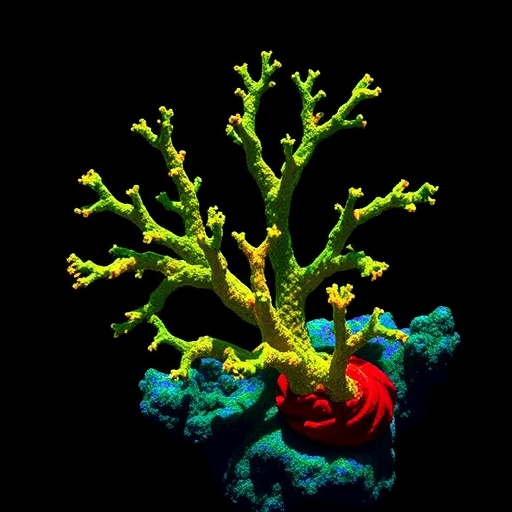In a groundbreaking development that could revolutionize the study of ancient climates, a University of Sydney PhD student has unveiled a pioneering technique to non-invasively peer inside fossilized coral skeletons, unlocking unprecedented details about Earth’s environmental history. Carra Williams, working in close collaboration with the Australian Nuclear Science and Technology Organisation (ANSTO), has harnessed neutron computed tomography (NCT) to visualize minuscule, well-preserved regions of coral mineral, dramatically enhancing the accuracy of climate reconstructions spanning hundreds of thousands of years.
This novel application of NCT represents a major advance over traditional methods that often relied on physical sectioning or destructive chemical analysis, which risked damaging precious fossil samples. By utilizing neutrons — particles that penetrate dense materials unlike conventional X-rays — the research team was able to generate detailed three-dimensional maps revealing the spatial distribution of aragonite, the original coral mineral, amidst areas altered by diagenesis to calcite. This distinction is vital because aragonite retains critical paleoenvironmental signals locked within its structure, while calcite formation commonly obliterates such data.
Corals construct their skeletons primarily from aragonite, a form of calcium carbonate. However, over geological timescales, aragonite is liable to convert into the more stable calcite through diagenetic alteration, a process akin to the aging and weathering of a fragile manuscript. This mineralogical transformation has long been a stumbling block for scientists attempting to accurately date fossils or extract reliable climatic information, often relegating many specimens as unusable. Williams’ technique, by contrast, is akin to finding intact pages within a weathered book, preserving climate signals previously thought lost.
Neutron computed tomography operates by directing beams of neutrons produced at ANSTO’s OPAL research reactor through coral samples, generating images based on variations in neutron attenuation. Unlike X-rays, which primarily differentiate structures by density, neutrons have a unique sensitivity to hydrogen atoms, abundant in aragonite due to its water and organic content, but significantly reduced in calcite. This sensitivity enables unprecedented contrast, allowing researchers to non-destructively discern mineral phases with micrometer-scale resolution.
The implications of this work extend far beyond the laboratory. By recovering and extending robust sea-level and climate timelines, scientists can better articulate how coral reef systems responded to past environmental stresses. Such insights are crucial for projecting future reef resilience or vulnerability under accelerating anthropogenic climate change, encompassing factors like ocean warming, acidification, and rising sea levels — threats that imperil coral ecosystems globally.
The research analyzed an assemblage of four coral core samples spanning a vast temporal range. These ranged from a modern calibration specimen sourced directly from One Tree Reef in the Southern Great Barrier Reef to fossil specimens spanning from approximately 1,650 years ago in Papua New Guinea to a Mid-Pleistocene fossil dating back nearly 600,000 years from the Great Barrier Reef. These multi-age samples enabled rigorous evaluation of the method across varying states of fossil preservation, demonstrating its broad applicability.
Supervised by coral reef history expert Professor Jody Webster, the project bridges cutting-edge nuclear imaging technology with foundational geoscience. Webster emphasizes that coral reefs function as sensitive environmental recorders, archiving shifts across climatic thresholds and tipping points. Unlocking this prehistoric data reservoir can transform our understanding of ecosystem responses to environmental perturbations, providing a critical context in today’s rapidly warming oceans.
Importantly, the neutron tomography scanning preserves the pristine integrity of samples, circumventing the need for invasive sectioning or chemical treatments that traditionally risked sample destruction. This capability ensures that rare and valuable coral fossils can be comprehensively evaluated without jeopardy, fostering preservation alongside scientific discovery.
Williams’ innovative application is the first globally reported utilization of neutron computed tomography as a diagnostic tool to screen fossil coral for diagenetic alteration specifically tailored to geochronological and paleoclimatic inquiries. This novel approach extends the analytical toolkit available to climate scientists and geoscientists, underscoring the synergy between nuclear science and Earth systems research.
Published in the esteemed journal Geochemistry, Geophysics, Geosystems, this study reflects a fruitful partnership between the University of Sydney and ANSTO, showcasing the capacity for university researchers and government nuclear facilities to collaboratively accelerate environmental science. This synergy not only propels coral paleoclimate research forward but also affirms the importance of interdisciplinary collaboration in addressing global scientific challenges.
The findings position the University of Sydney as a vanguard institution where students can lead transformative scientific breakthroughs with worldwide relevance. The blend of high-resolution imaging, sophisticated mineralogical discrimination, and environmental context sets a new paradigm for reconstructing Earth’s past climates, offering indispensable knowledge to policymakers, conservationists, and scientists committed to mitigating the impacts of global climate change.
Subject of Research: Not applicable
Article Title: Neutron computed tomography: a novel high-resolution, non-destructive method for screening fossil coral for diagenetic alteration for geochronologic and paleoclimatic reconstructions
News Publication Date: 1-Oct-2025
Web References:
https://agupubs.onlinelibrary.wiley.com/doi/10.1029/2025GC012439
References:
Williams, C. et al., ‘Neutron computed tomography: a novel high-resolution, non-destructive method for screening fossil coral for diagenetic alteration for geochronologic and paleoclimatic reconstructions’, Geochemistry, Geophysics, Geosystems (2005). DOI: 10.1029/2025GC012439
Image Credits:
The University of Sydney
Keywords:
Coral reefs, Coral, Imaging, Tomography, Earth systems science, Geology, Geologic history, Climate change




